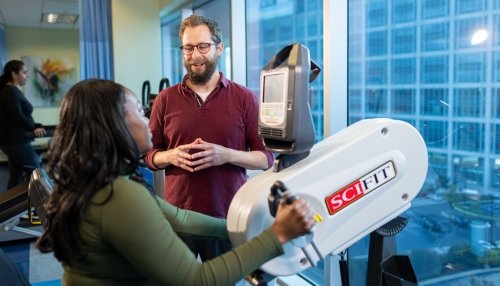Movement Therapy at Midwestern University Clinics Assist Patients with Mobility
How movement therapy helps patients to increase mobility, manage pain, and improve their quality of life.

Around 60 million adults suffer from arthritis, and it is the number one cause of disability in the United States, according to the Arthritis Foundation. Through Midwestern University’s Physical Therapy (PT) Institute, patients suffering from arthritis can receive movement therapy to increase mobility, manage pain, and improve their quality of life.
Mark Kargela, D.P.T., Clinical Assistant Professor at the PT Institute in Glendale, AZ, and Thomas Dillon, D.P.T., Clinical Assistant Professor at the PT Institute in Downers Grove, IL, spoke about demystifying arthritis and some of the advantages of movement therapy as a part of the Community Health Lecture Series. The next one is on July 11, Demystifying Spinal Disc Issues, available though Facebook, LinkedIn, and YouTube.
According to Drs. Kargela and Dillon, arthritis is a deeper issue than just a matter of mechanics. Kargela added, “You may hear scary sounding terms such as wear and tear, less joint space, limited mobility and pain, cartilage degeneration, structural changes, and the development of bone spurs. None of these are barriers to someone improving movement and paint around the joint.” Research is pointing to the fact that arthritic inflammation also involves inflammation throughout the system that is impacted by our metabolic health. Our metabolic health is influenced by blood sugar levels, cholesterol, and body fat. All of these issues can negatively impact our body and make inflammation across the body worsen.
Diagnostic imaging alone cannot paint the full picture of the pain from arthritis. Dr. Kargela said some patients may have an X-ray indicating a severe level of arthritis, but they do not experience pain. Other patients may have X-rays that show a mild case of arthritis, but they suffer severe pain.
According to Dr. Dillon, when people suffer from arthritis, they might avoid putting weight on the affected area, such as the knee or the hip, to prevent further pain. But in order for the afflicted joint to improve functionality, movement is necessary. Midwestern University experts advocate for movement therapy to assist with mobility.
“Weight-bearing exercise [is] incredibly healthy for the joint, even an arthritic joint,” Dr. Dillon said. He added if patients avoid movement, it can worsen arthritis. Dr. Kargela added, “You have to eventually engage and load that joint. The crucial thing that we help people with is the how much, how frequently, and how often, and there isn’t a recipe that you can go look on Google where it fits everybody.”
At the Midwestern University clinics, movement therapy is specialized for every patient, according to Drs. Kargela and Dillon. The treatment will vary from patient to patient based on the patient’s metabolic health, level of mobility, and history of movement. Some patients may require more therapy sessions.
The therapy sessions are led by certified physical therapists with students training for doctoral-level degrees. After the initial session, the physical therapists see if the patient experiences improvement after 24-48 hours, Drs. Kargela and Dillon said. Some patients were pleasantly surprised at the improvement in mobility and decrease in pain. With exposure to incremental exercise over time, patients may not have to consider other options, such as surgery, for an improved quality of life.
The first step in treatment is physical therapy to see if this treatment can alleviate arthritis pain and lack of mobility. “You’re loading the body to where it gets tolerant to load,” Dr. Kargela said, and added, “It adapts to load provided you structure that load at an appropriate dosage for your unique situation.”
“I’m a big believer of first step conservative care,” Dr. Dillon said, and added this can be a combination of exercise, massage, pain medication, and possibly a knee brace that is individually tailored to the patient.
For cases where physical therapy is not enough of an improvement for the patient, hyaluronic injections could be recommended in addition to the physical therapy. However, for the cases where movement therapy and injections are not effective enough for the patient, then surgeries, such as hip or knee replacements, are an option.
In addition to treating patients with arthritis, the Physical Therapy Institutes in Downers Grove or Glendale offer specialty programs to assist patients with back and neck pain, as well as chronic pain. Students interested in pursuing a career in physical therapy can learn more by visiting the Midwestern University's Doctor of Physical Therapy page.
Visit Dr. Kargela's profile and Dr. Dillon's profile to learn more about their work at Midwestern University.



